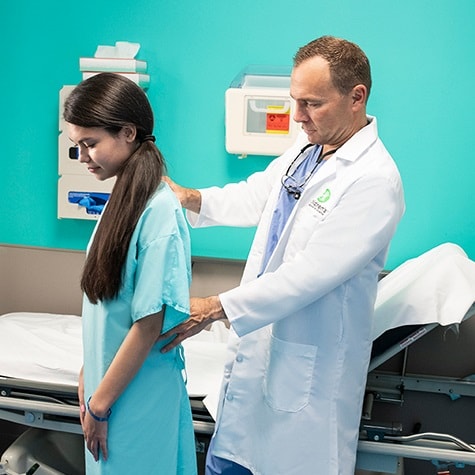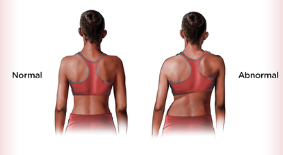If your child has scoliosis or spinal deformity, our skilled team of pediatric spine surgeons will carefully evaluate their condition and determine the best option for treatment. There are a variety of methods and procedures we can use to treat a spine that is curving. If the curve of the spine is significant, your child’s doctor may recommend halo-gravity traction prior to surgery.
Halo-gravity traction, also known as halo traction, is a way to gently stretch and straighten a curved spine prior to spine surgery. Not every child who needs spine surgery will require halo traction.
Spine conditions that may benefit from halo traction include:
- Severe scoliosis
- Early onset scoliosis
- Syndromic scoliosis
- Severe kyphosis
- Cervical instability, including cervical kyphosis and basilar invagination
- Spine deformities from birth
- Neuromuscular scoliosis
Your child's surgeon will determine how long your child will be in the halo device prior to surgery, and your child will remain in the hospital throughout the entire traction process. Once this straightening process is complete, your child will then move forward with spine surgery, such as spine fusion or a growth friendly spine surgery like growing rods, to correct the curvature of the spine.
Advanced procedures like halo traction take extensive knowledge and precision. Your child’s spine deserves the expertise of our pediatric-trained spine team. Don’t settle for another spine program that doesn’t specialize in treating kids and teens. Not only do more parents trust Children’s to perform their child’s spine surgery than any other pediatric hospital in the country**, but we are also the only nationally ranked pediatric orthopedics program in Georgia.*

Our team created a private Facebook group for scoliosis families.
We know that the scoliosis journey can be a long one—from diagnosis and bracing through surgery and recovery. This page offers forums for asking questions, sharing tips and celebrating milestones with other spine patient families.
Start connectingThe halo-gravity traction device is designed to apply gentle, ongoing stretching to the spine during a three to eight week period using two components:
- The halo, a large metal ring that attaches to and goes around your child’s head.
- The pulley system, which is attached to the halo, and the hospital bed, wheelchair or walker.
What to expect with halo traction
The first step in the halo traction procedure: attaching the lightweight metal ring or halo to your child’s head. Your child is put to sleep with general anesthesia for the procedure. Your child’s surgeon will insert pins into the bone of the forehead to secure the halo to your child's head.
Next, the halo is attached to a pulley system. Weights are slowly added to the pulley system to pull the head upward to stretch the spine. How much weight and how often it’s increased will depend on your child’s size and how quickly their spine is straightening. The weights can be removed for short periods of time to allow your child to move freely and to give their body time to adjust if needed.
Your child’s care team will keep a close eye on their movements and evaluate their strength while in traction. They’ll get X-rays regularly to monitor their progress. Your child will still be able to move and play while in traction using specialty wheelchairs and walkers.
When your child’s spine reaches a favorable position for surgery, surgeons can then move forward with surgery to permanently stabilize the spine. Depending on the age of your child, your doctor may perform a spine fusion or another type of spine surgery.

Here's a resource to make surgery preparation a whole lot easier.
Our team has created special tools to help answer your questions and make this journey easier.
HOW TO PREPAREHalo traction is necessary for some kids prior to spine surgery because it stretches the spine slowly. This reduces the risk of injuring the nerves or soft tissues around the spine during surgery. Kids who may need halo traction include those whose:
- Spine is too stiff or curved to straighten it safely all at once.
- Bones are too weak to straighten the spine safely all at once.
- Nerves around the brain and spinal cord need the spine be straightened slowly, so they are not damaged or irritated.
Your child will stay in the hospital during the halo traction process. Here’s how our patients make the most of their time in traction.

New friends Ben and Aleah visit the helipad at Children’s Egleston Hospital.
*Pediatric Health Information System (2023), as prepared by the Children’s Hospital Association. This report compares clinical data annually for more than 52 pediatric hospitals in the U.S.
**No. 10 on the U.S. News & World Report “Best Children’s Hospitals” list for 2023-24.
Contact Us 404-255-1933





